We may earn revenue from the products available on this page and participate in affiliate programs. Learn more ›
Bird feeder cameras make documenting our feathered friends fun and easy, but they aren’t created equally. Some are best for bird-watching in your own backyard, while others are better suited to remote locations. More expensive models have features like solar panels, video options, and smart bird identification, while basic, budget models make feeder photography accessible for just about everyone. No matter what you are looking for, the best bird feeder cameras will allow you to capture quality images of the birds who call your area home.
Best overall: Bird Buddy Smart Bird Feeder
Best trail camera: TECHNAXX Full HD Birdcam TX-165
Best for bird boxes: Hawk Eye HD Nature Cam
Best for hummingbirds: BirdDock Hummingbird Feeder Camera
Best for bird identification: Netvue Birdfy Pro
Best budget: WYZE Cam v3
How we chose the best bird feeder cameras
There are dozens of bird feeder cameras on the market. Though many of them have the same basic features, they don’t all offer the same level of important features like durability, battery life, and accuracy of species detection.
To arrive at our top picks, we relied on our own assessment of each device, including hands-on experience with multiple models. Because bird feeder cameras must be durable, weatherproof, and offer long-lasting performance, we also leaned heavily on user experiences and favored well-reviewed products.
Features like accurate bird identification, solar panel availability, and useful accessories also helped push some models into the limelight. Other options like real-time notification and color night vision were nice to have but not essentials. Still, they didn’t tend to figure into our final decision simply because of their somewhat limited value for bird photography.
The best bird feeder cameras: Reviews & Recommendations
Choosing a bird feeder camera can be tough. There are dozens of available models, and the prices can range from less than $50 all the way up to $400 or more. The key to finding the right bird feeder camera is not necessarily shopping by price but knowing which features are must-haves and which are not. Not everyone will benefit from AI, for example. You may even prefer to use your own knowledge to identify the birds in your photographs. Below are our favorite options, suitable for a range of situations and users.
Best overall: Bird Buddy Smart Bird Feeder
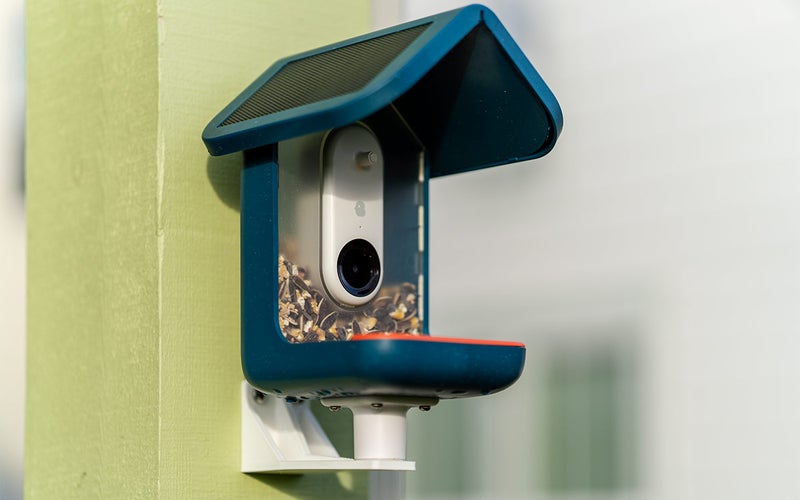
Specs
AI: Yes, identifies more than 1,000 bird species
App compatibility: Android and iOS
Resolution: 5-megapixel photos, 720p video
Battery: 4000 mAh rechargeable lithium-ion battery, optional solar panel
Pros
Sharp images with a 120-degree field of view
Weatherproof from -5°F to 120°F
The smartphone app allows you to see feeders all over the world
Compatible with an optional solar panel and lots of accessories
Three mounting options
Cons
No local storage, so it can’t be used without Wi-Fi
Video resolution is lower than some competitors
The Bird Buddy bird feeder camera is relatively new, but it has much to offer, so it earns our top spot. The bird feeder is attractively designed, so it will look nice in your yard or on your deck with some solar lights, which is an important feature for many. It’s available in blue or vibrant yellow, so you can choose an option that fits your style best. I really enjoy the look of the blue Bird Buddy on the side of my porch, which is a big plus.
The camera module is removable, which is important when it comes time to clean the feeder. It can take five-megapixel photos or offers 720p live-streamed video. The image quality won’t be that of your dedicated mirrorless or DSLR camera, but it is nicely detailed and properly exposed even in backlit situations. And being able to tune in to watch live as a bird chows down is pretty neat.
The camera’s 120-degree field of view is wide enough to capture birds hanging out on the feeder’s side. You can also buy multiple accessories through Bird Buddy to extend the perch or feed different species. With the solar roof (the model we thoroughly tested and reviewed), you’ll never need to think about charging the camera. Without the solar roof, you’ll need to charge the camera every 5 to 15 days.
The Bird Buddy relies on AI to automatically recognize over 1,000 species of birds. The Bird Buddy app notifies you when you have new visitors to your feeder, which is always exciting. You can even browse other Bird Buddy devices all over the world to see species that you wouldn’t otherwise encounter. Plus, the images from your device contribute to migration information for conservation databases. You’ll be helping science progress while getting fun images of your feathered friends.
Best trail camera: TECHNAXX Full HD Birdcam TX-165
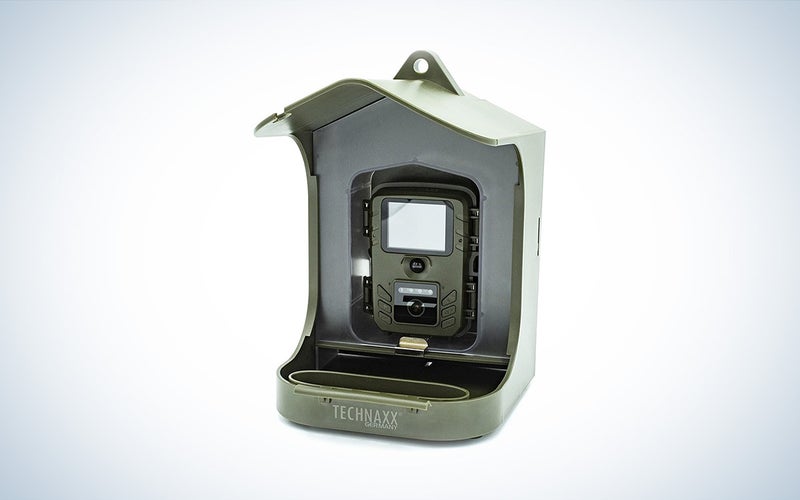
Specs
AI: None
App compatibility: N/A, no app available
Resolution: 8-megapixel photos, full HD 1080p video
Battery: 4 AA batteries give it a working time of up to 6 months
Pros
Sturdy trail-cam style feeder
6-month battery life
Removable water basin means it can be a feeder or a birdbath
Captures slow-motion video
Cons
No smartphone app or bird identification features
Memory card storage is less convenient than Wi-Fi or Bluetooth
This hybrid bird feeder camera is as tough as any trail camera. However, unlike most trail cameras, it can focus as close as 2 to 6 inches and offers a 100-degree field of view. This means you’ll get much better images of visiting birds than you would with a typical trail cam. The TX-165 takes standard AA batteries but has a working time of up to 6 months. You can leave it in a secure, remote location for a long time without worrying about the battery going flat.
The TX-165 also has a few features you won’t find on other bird feeder cameras. You can fill it with birdseed or fill the removable basin with water and turn it into a birdbath camera. It also takes impressive eight-megapixel images and full HD 1080p video. It’s also capable of 25 frames per second for slow-motion videos.
Best for bird boxes: Hawk Eye HD Nature Cam
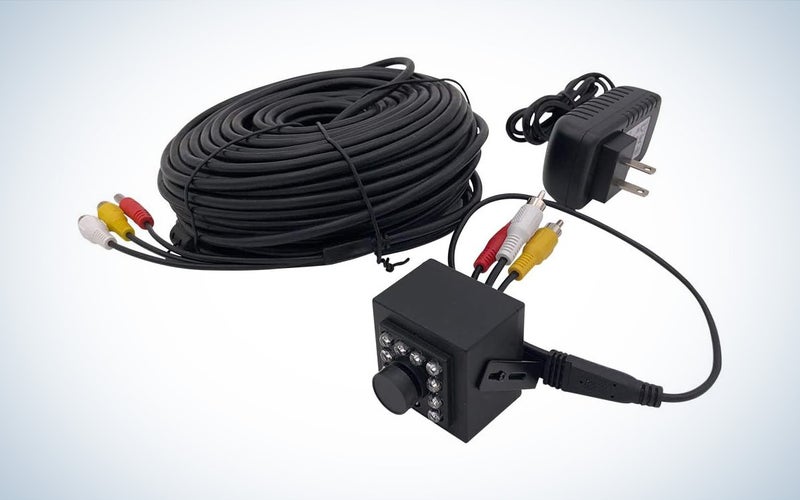
Specs
AI: None
App compatibility: N/A, no app available
Resolution: 700 tvl (television lines)
Battery: None (includes a 75-foot power cable)
Pros
Compact, so you can hide it almost anywhere
Night vision lets you capture clear images in poor light
Durable and temperature-tolerant to between 35°F and 105°F
Cons
Only shoots video
Not waterproof
Needs to be plugged into a power supply
Birds do a lot more than just eat birdseed, so at some point, you might want to step up to a birdhouse camera. Because the Hawk Eye Nature Cam isn’t built into a feeder, it’s much more flexible than most bird cams. Its small size means you can put it anywhere—on treetops, fence posts, or even in animal burrows (though please exercise caution when putting it down a snake hole). Or it can be wired discreetly into a bird box for a 24/7 look at growing bird families, from egg to fledgling.
The Hawk Eye Nature Cam is meant for live-streaming to your television set. The video resolution is clear and sharp, with 700 tvl (television lines) and 10 infrared diodes. This lets you view clear video even in the darkened environment of a typical bird box. Note, however, that you will need an RCA to USB adapter if you have a modern TV.
The Hawk Eye does have a few drawbacks. It has no battery, so you’ll have to mess with a long extension cord to get it set up. It also isn’t waterproof. If you want to attach it to an unsheltered location, you’ll have to build waterproof housing or limit your use to dry weather. Finally, you can connect the camera to your PC and use additional software to grab photos and video segments from the live stream, but it’s not designed to capture high-resolution stills.
Best for hummingbirds: BirdDock Hummingbird Feeder Camera
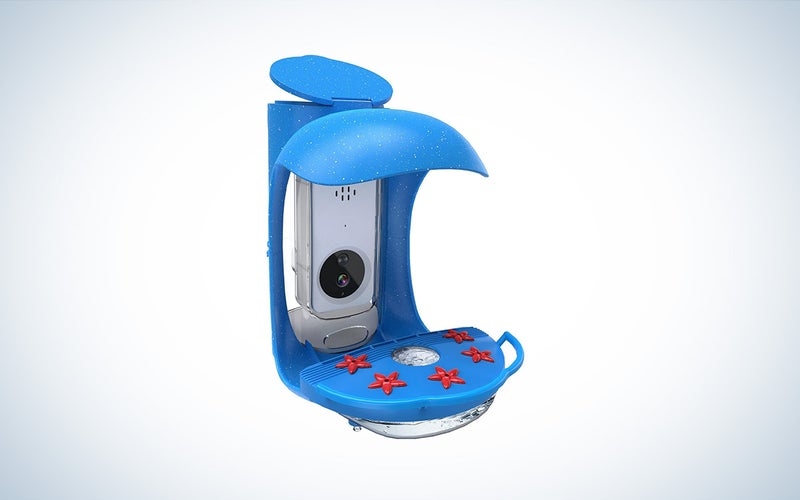
Specs
AI: Yes, identifies species and alerts you when birds approach
App compatibility: Android and iOS
Resolution: 2-megapixel photos, full HD 1080p video
Battery: 6400 mAh rechargeable batteries provide 20 to 30 days of operating time
Pros
AI can recognize around 5,000 different species, including hummingbirds
Rechargeable batteries provide 20 to 30 days of use
Hummingbird attachment is removable
Con:
Still photos are much lower resolution than those shot by similar feeders
The app is clunky and difficult to use
The BirdDock is a flexible bird feeder camera that isn’t limited to just capturing photos of seed-eaters. It also offers a removable hummingbird attachment featuring five flower-shaped feeding ports with 0.16-inch holes to keep bees and other insects out. When you want to switch to photographing songbirds, you can remove the hummingbird feeder and fill the device with seeds.
Like other AI feeders, the BirdDock will identify species and alert you when one is approaching the feeder. It has night vision, too, which could help you identify other critters that visit your feeder overnight. This bird feeder camera features a 160-degree field of view and can be used with or without an SD memory card. It provides an impressive battery life of up to 30 days. You can also purchase a separate solar panel to keep the device charged in sunny weather.
The BirdDock has two primary drawbacks: It captures still photos at a relatively low resolution of only two megapixels (though it does also capture full HD 1080p video). It also doesn’t have an especially user-friendly app. Some users complain that the bird identification feature isn’t accurate and that the app frequently disconnects from the camera.
Best for bird identification: Netvue Birdfy Pro
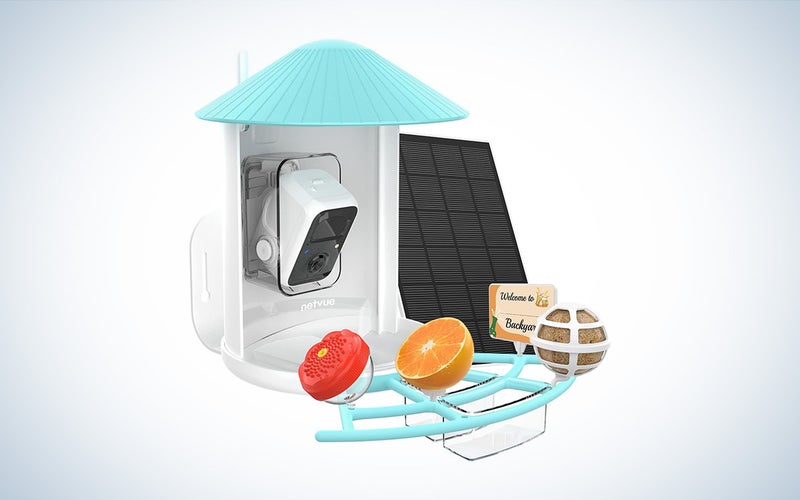
Specs
AI: Yes, identifies more than 6,000 different species
App compatibility: Android and iOS
Resolution: Full HD 1080p video
Battery: 5000 mAh rechargeable batteries
Pros
Can identify more than 6,000 different species
Long battery life (the manufacturer claims up to six months of use)
Extra features like squirrel recognition and color night vision
Cons
The bird identification service costs extra
Storing photos on the cloud requires a subscription
The Netvue Birdfy rivals the Bird Buddy with features like ease of use, durability, and photo quality. It has an impressive array of extra features like color night vision. The AI can recognize squirrels, and the built-in microphone lets you yell at them when they’re caught robbing the feeder. You can also upgrade your feeder with add-ons like a solar panel, hummingbird feeder, and perch extension.
The Birdfy has the same features as most other feeders, including automatic capture/motion detection and real-time notification. It takes clear video at close range, provides a 135-degree field of view, and even offers 8x magnification if you want to study the fine details.
Birdfy has an impressive database of 6,000 species, though reviewers note that it isn’t always accurate. When it does misidentify a bird, you have the option to submit a report via the app. This is evidence that Netvue is constantly working to improve its software.
The primary drawback of the Netvue bird feeder camera is you may have to pay for various subscriptions depending on what features you want access to. For example, if you want to take advantage of the bird identification feature, you must pay for a subscription. Likewise, a subscription is required if you want to store photos on the Netvue Cloud for longer than 30 days.
Best budget: WYZE Cam v3
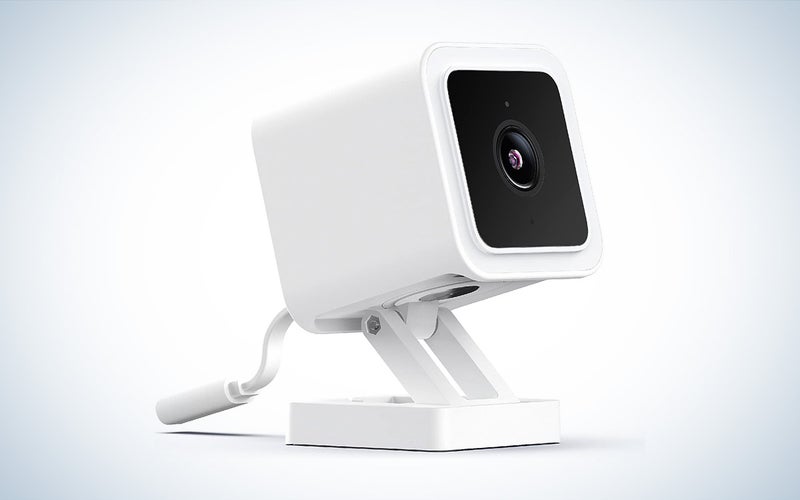
Specs
AI: No species identification
App compatibility: Android and iOS
Resolution: 1080p full HD video
Battery: No battery
Pros
Affordable
Weatherproof
Compact for easy mounting
Cons
Minimum focus distance is around 12 inches
No battery; needs to be plugged into a power supply
Bird feeder cameras with all the bells and whistles can be expensive. A $200 feeder might be outside your budget, or you may not need all the features that expensive bird feeder cameras offer. The WYZE Cam v3 is essentially an outdoor security camera. You won’t be able to fill it with birdseed or attach a hummingbird accessory. But you can mount this sturdy little camera next to any commercial bird feeder or install it close to a high-traffic part of your backyard.
The WYZE Cam v3 offers all the basic features you need in a bird cam. It’s weatherproof with an IP65 rating. It takes photos when it senses motion, and it has an app so you can see what’s happening outside in real-time.
The WYZE Cam does have a few drawbacks. One of these is the focus distance. While most dedicated bird cams can focus on subjects as close as a few inches, the WYZE Cam isn’t designed for closeups. You’ll have to mount it at least a foot away from your feeder, meaning you won’t see a lot of detail in your photos.
The WYZE Cam is also wired. It comes with a weatherproof six-foot USB cable, so you’ll have to install it close to your home. On the plus side, once installed, you won’t have to worry about changing or recharging the battery or losing your video stream on a cloudy day.
Things to consider before buying a bird feeder camera
If you love bird watching but don’t want to sit waiting with your binoculars, a bird feeder camera will allow you to capture photos and videos of birds even when you aren’t around.
A bird feeder camera is meant for permanent outdoor use. This means it needs features you probably don’t consider when shopping for other photography gear. Here are some of the most important things you’ll want to think about when shopping for a bird feeder camera.
Durability
Bird feeder cameras can be subject to some serious abuse. The sun’s UV rays and hot temperatures can degrade plastic casings over time. These devices must also withstand storms and sprinklers, remaining waterproof from season to season. Of course, they should also be tough enough to handle the beaks and claws of visiting critters—not just the birds they’re intended for but other potential visitors like squirrels and mice.
Image quality
The image quality of bird feeder cameras is dependent on a few things. Resolution is the first thing most think of, and indeed, it is important with these devices. If you want clear, sharp images, look for bird feeder cameras with higher resolution. These compact cameras won’t offer numbers you may be used to in smartphones or mirrorless cameras, though. Five to eight megapixels for stills and 1080p for video tend to be the highest available at the moment. However, if you aren’t concerned with high levels of detail, you could save some money and opt for a device with a less impressive resolution.
The second factor of image quality is close focusing distance. The majority of shots taken by a bird feeder camera will be up-close. As a result, look for a device capable of getting clear photos at a very short distance. Even as close as a few inches is ideal. Finally, birds don’t tend to sit still for long. Because of this, the camera should be able to freeze action, even in low light conditions like early morning or cloudy days.
WiFi connectivity
WiFi isn’t necessarily a critical feature, but it’s something to consider if you’re going to keep your feeder close to your house. Most people don’t want to trek outside daily to download photos or swap out a memory card. A WiFi connection will let you see what your camera captured at any time of day in any weather. Treating it like a smart-home device will save you from having to venture into the cold, heat, or rain unless you need to change the battery or add birdseed.
Pay attention to the range of the device, too. Shy birds won’t approach your device if it is too close to your home. If it’s too far away, you won’t be able to view your photos without exiting your home.
Mounting options
Each bird feeder camera will have somewhat different requirements for how you install them. Some require a pole, some can be mounted to a fence post, and others can be hung. Depending on where you want the feeder and what tools you have available for installation, some of these options may be better than others for your particular needs.
Battery life
Some bird feeder cameras take basic replaceable AA batteries; others rely on solar panels to power internal rechargeable batteries. Either way, you’ll want to pick a camera that isn’t power-hungry. A good battery will ensure you aren’t constantly changing batteries or missing photos because your camera goes dark on a cloudy day.
Choosing a camera with motion detection is a good place to start. These cameras only activate when there’s something to take a photo of, which helps the battery last longer.
FAQs
Q: How do bird feeder cameras work?
Most bird feeder cameras are triggered by motion. When a bird visits the feeder, the camera will capture a still photo or record video, depending on its design. Some smart bird feeder cameras can also identify species by comparing photos to thousands of stored images of each individual bird species.
Q: What color bird feeder attracts more birds?
A 2017 study found that green or silver bird feeders tend to attract the most visitors, but color preference also seems to be species-specific. Robins in the study, for example, preferred black feeders, while greenfinches and starlings didn’t seem to care about color at all.
Q: Where should I put a bird feeder camera?
Bird feeders should be placed in open spaces but not too far from potential cover. The Humane Society recommends placing feeders 12 feet from brush and trees. This prevents predators from hiding near the feeder and gives the birds cover to fly to if they feel threatened.
Q: Do infrared cameras bother birds?
Infrared light is invisible to birds, so a camera inside a bird box will give you clear pictures while the bird remains in darkness.
Final thoughts on the best bird feeder cameras
Best overall: Bird Buddy Smart Bird Feeder
Best trail camera: TECHNAXX Full HD Birdcam TX-165
Best for bird boxes: Hawk Eye HD Nature Cam
Best for hummingbirds: BirdDock Hummingbird Feeder Camera
Best for bird identification: Netvue Birdfy Pro
Best budget: WYZE Cam v3
Once limited to nature photographers with long telephoto lenses and lots of patience, bird feeder cameras have made bird photography nearly effortless and available to almost anyone. That doesn’t necessarily mean any camera will do, though. Thinking about what you want to get out of your investment is an important first step in choosing a feeder. If you’re hoping to get up-close, detailed shots, pay attention to the example shots provided by the manufacturer and uploaded by users. Consider how important good battery life is to you, and ask yourself if you really need a camera that will identify already familiar local birds.
Why trust us
Popular Science started writing about technology more than 150 years ago. There was no such thing as “gadget writing” when we published our first issue in 1872, but if there was, our mission to demystify the world of innovation for everyday readers means we would have been all over it. Here in the present, PopSci is fully committed to helping readers navigate the increasingly intimidating array of devices on the market right now.
Our writers and editors have combined decades of experience covering and reviewing consumer electronics. We each have our own obsessive specialties—from high-end audio to video games to cameras and beyond—but when we’re reviewing devices outside of our immediate wheelhouses, we do our best to seek out trustworthy voices and opinions to help guide people to the very best recommendations. We know we don’t know everything, but we’re excited to live through the analysis paralysis that internet shopping can spur so readers don’t have to.
>>> Read full article>>>
Copyright for syndicated content belongs to the linked Source : Popular Science – https://www.popsci.com/gear/best-bird-feeder-cameras/










